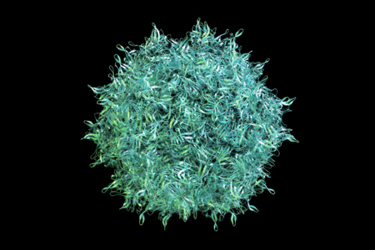The Latest Strategies For Quantifying AAV Capsid Titer
By Marilia Barros, Ph.D., Regeneron

The assessment and monitoring of critical quality attributes (CQAs) are fundamental in the development of adeno-associated virus (AAV)-based gene therapies, as these attributes are closely linked to product quality, safety, and efficacy. Accurate quantification of capsid titers is essential for determining appropriate dosing regimens, as the total capsid count impacts both the efficacy and safety of the therapy.
Specifically, AAV capsids can trigger immunogenic responses, which are a primary cause of toxicity and reduced durability in AAV-based treatments. Moreover, precise quantification of total capsids is vital for optimizing downstream processing. This quantification facilitates the management of product load during purification and formulation stages, rather than focusing solely on potency. Understanding the total concentration of AAV capsids is also crucial for evaluating the colloidal stability of the drug product under various formulation conditions. The tendency of capsids to aggregate is influenced by their concentration and environmental factors, making accurate measurement essential for ensuring the stability and quality of the final AAV product
Current Challenges And Emerging Technologies
Having established the importance of accurate capsid titer quantification, it is crucial to review the current landscape of analytical methods designed to measure capsid titer. Traditionally, enzyme-linked immunosorbent assay (ELISA) has been the gold standard for quantifying AAV capsid titer. However, ELISA methods often face significant limitations, including extended turnaround times, low throughput, substantial sample volume requirements, and considerable assay variability. These limitations hinder the routine application of ELISA for high-throughput settings, necessitating the development of alternative methods that can support accelerated AAV formulation and development processes.
Given the stringent clinical timelines and material constraints associated with early-stage AAV-based gene therapy programs, there is a pressing need for more efficient analytical methods. To address this, comprehensive assessment and optimization of currently available orthogonal capsid titer methods for AAVs are required.
While not all existing methods were evaluated, this review provides a representative analysis of the most commonly used methodologies. This article covers both established and emerging analytical techniques for quantifying AAV capsid titer. Antibody-based methods and optical or scattering-based methods were assessed based on key performance criteria, including serotype specificity, throughput, linearity range, sample volume, and turnaround time. This evaluation aims to highlight the advantages and disadvantages of each method, providing insights into their suitability for various stages of AAV process and product development.
Antibody-based methods, including ELISA and biolayer interferometry (BLI), have traditionally been used for capsid titer quantification.
ELISA, for example, quantifies capsid titer through a photometric reaction. This method involves capturing AAV capsids on a solid surface using immobilized antibodies, followed by a colorimetric detection step facilitated by biotin-conjugated antibodies and streptavidin peroxidase. Despite its specificity and robustness, ELISA's requirement for multiple incubation and washing steps results in a total turnaround time of several hours, making it less ideal for high-throughput settings without automation.
Automated ELISA, as an alternative platform, represents an advancement in reducing manual labor. It utilizes microfluidic cartridges with built-in calibration curves and preloaded reagents, automating all steps of the traditional ELISA. While this method reduces labor intensity, it is currently limited to a few serotypes. Custom cartridges for additional serotypes can be developed but may require significant time.
Biolayer interferometry (BLI) offers a label-free approach, measuring changes in optical thickness of a submerged probe to quantify biomolecular interactions, including AAV capsid concentration. Although BLI provides real-time data and good specificity, it also requires calibration curves and may not detect aggregates, potentially leading to an underestimation of total capsid concentration.
Considered emerging alternatives are size-exclusion chromatography coupled with multi-angle light scattering (SEC-MALS) and mass photometry.
SEC-MALS method combines size-exclusion chromatography with multiple detection techniques — ultraviolet (UV) absorbance, refractive index (RI), and multi-angle light scattering (MALS) — to offer a comprehensive analysis of AAV capsids that goes beyond capsid titer information (empty-full ratio and aggregation). Compared to antibody-based methods, SEC-MALS provides a high-throughput, serotype-independent solution with enhanced accuracy and minimal sample preparation, making it particularly suited for process development and characterization of AAV products.
Mass photometry is a rapid and sensitive analytical technique that requires minimal sample volumes and concentrations. This makes it particularly advantageous for evaluating AAV samples, especially when working with small batch sizes. A notable feature of mass photometry is its titer estimation tool, which provides comprehensive data on all AAV capsid populations within a sample, including empty, full, and partially filled capsids. This capability allows for a detailed assessment of the sample’s composition and aids in more accurate characterization of AAV products.
All Methods Have Shortcomings
Several challenges can be encountered when measuring capsid titer in stressed samples: decrease in mass/titer and enhanced aggregation complicate comparisons between methods and their practical application.
Overall, each method has its own limitations. While ELISA-based method may face issues with turnaround time and serotype specificity, BLI might not detect all types of aggregates. SEC-MALS and mass photometry, though promising, may face challenges with stressed sample and aggregation, potentially affecting the accuracy of capsid titer measurements under certain formulation and thermal stability conditions. The assessment aims to facilitate informed decision-making regarding the selection of the most appropriate method for quantifying capsid titer.
The selection of the appropriate method for quantifying AAV capsid titer is crucial for advancing AAV-based gene therapies. Traditional methods like ELISA offer high specificity but are less suited for high-throughput needs. Emerging methods provide a compelling alternative by offering high-throughput, serotype-independent quantification with enhanced accuracy and minimal sample requirements.
As the field progresses, it is essential to weigh the advantages and disadvantages of each method and consider their applicability to specific stages of drug development. The continued evolution of analytical techniques promises to streamline AAV formulation and accelerate the development of gene therapies. By adopting and optimizing these advanced methods, researchers can improve process efficiency, ensure product quality, and ultimately enhance the therapeutic outcomes for patients.
About The Author:
 Marilia Barros is an expert in biologics and gene therapy drug product development, providing primary support for therapeutic areas in early through late-phase development projects. Currently, Dr. Barros is a principal scientist at Regeneron developing strategies to identify and implement new technologies to advance the genetic medicine pipeline and serves as CMC drug product formulation lead for Regeneron’s gene therapy programs. She received her Ph.D. in physics from Carnegie Mellon University and has worked at NIST Center for Neutron Research, Memorial Sloan Kettering Cancer Center and Bristol Myers Squibb where she developed and led internal and external scientific collaborations to drive key innovation that impacted the progression of the sterile products portfolio and to support drug development and new strategies of drug product formulation.
Marilia Barros is an expert in biologics and gene therapy drug product development, providing primary support for therapeutic areas in early through late-phase development projects. Currently, Dr. Barros is a principal scientist at Regeneron developing strategies to identify and implement new technologies to advance the genetic medicine pipeline and serves as CMC drug product formulation lead for Regeneron’s gene therapy programs. She received her Ph.D. in physics from Carnegie Mellon University and has worked at NIST Center for Neutron Research, Memorial Sloan Kettering Cancer Center and Bristol Myers Squibb where she developed and led internal and external scientific collaborations to drive key innovation that impacted the progression of the sterile products portfolio and to support drug development and new strategies of drug product formulation.
